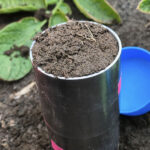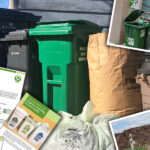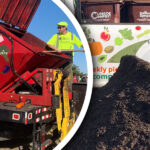
Sally Brown
BioCycle September 2014
The U.S. EPA created the WARM (WAste Reduction Model) to help solid waste planners and organizations track and voluntarily report greenhouse gas (GHG) emissions reductions from several different waste management practices. As such, the WARM model has been the place to turn to when making decisions about waste (resource) management for a very long time. And for a very long time, the WARM model considered yard trimmings and paper waste as much the same material as food scraps.
WARM also had the attitude that once you’d seen one landfill you’d pretty much seen them all. Fate of material within a landfill was also considered constant over time — same old decay in, decay out. This perspective limited incentives to divert food scraps from landfills and even gave landfills a bit of a leg up with green energy claims.
Not any more. Now WARM Version 13 is out and the world is a much better place. Take a look at this new and revised WARM model and it is abundantly clear that we live in a very different place than we did when I started writing this column in June 2007. The level of detail and attention that is now devoted to composting, landfilling and food scraps in the new WARM model is really impressive. Everyone involved in this version deserves praise. Focusing on food waste, for example, you can learn about how much energy it takes to grow different types of foods, process them and how much energy is required to transport them.
First off, food is no longer just food. Food now consists of three categories: Grains (16%), fruits and vegetables (61%) and dairy (22%). EPA has not gone vegetarian. They have just opted not to consider meat in this mix. Each category has its own level of detail and its own level of associated emissions. These emissions include the energy required to grow, process and transport the food — all of which is counted as wasted energy if these foods are also wasted. Source reduction typically gives you the largest savings overall.
Breakfast Emissions
Take your morning breakfast for example. In the new WARM model, I can decide if it is better to have corn-based (based on production in Iowa), rice-based (grown in Arkansas) or wheat-based (from Kansas) cereal or toast. A range of factors are included for each of these, such as the energy required to grind the wheat into flour and the energy to bake that flour into bread. I am not fully clear on the differences between emissions associated with process energy and materials energy and processing.
What I am clear on is the evils of bananas. I have had bananas on my granola every morning for years, considering them as a great source of potassium and as nature’s alternative to power bars. That was all before I read the new WARM model and understood the full impact of getting those bananas from the tropics to my bowl. Bananas require refrigeration on the boat as well as on the truck whereas other fruits produced in the U.S. only require refrigeration on the truck. Different spoilage rates and associated emissions are also now included in the model. And then we get to the milk or yogurt that you put on the cereal with the bananas. The process energy for the milk (in my case whole milk yogurt) that is added to the granola with the banana trumps all the rest in spades.
So this new model is robust and sophisticated enough that I will, for sure, reconsider my choices of breakfast fruit. For those who don’t and for those bananas that rot before they can be turned into banana bread, the new WARM also has revised and more sophisticated emissions factors for composting and landfilling.
Revised Factors
Food waste in landfills is now recognized as more likely to generate methane than office paper — about 7.13 MTCO2e per dry ton of food waste (or 1.75/wet ton) in comparison to 4.71 for office paper. I would still argue about that office paper value but am much more comfortable with the higher reactivity of the food waste. Faster decay rates for food waste have also been recognized. Decay rates tell you how quickly that leftover granola turns into methane. The faster the decay rate, the greater the chances are that the methane will escape into the atmosphere before any gas collection systems are operational. These decay rates range from 0.07 for a dry landfill to 0.43 for a bioreactor landfill with a national average of 0.26. These rates go with a semi complicated equation that I won’t copy here. The important point to know is that higher numbers mean that materials decay more quickly.
There is also the recognition that gas collection efficiency is not constant over time but varies with the stage of a particular landfill cell. WARM now gets that gas collection efficiency is zero when waste has been buried but the collection system isn’t operating. You may laugh, but this was a big battle. It is also recognized that no system is 100 percent efficient over time. This makes sense — how efficient can a system that covers acres and acres be? The net result here is emissions of 0.71 MTCO2e per wet ton of each of the different categories of food waste. Considering that the percent moisture for food scraps is typically between 20 to 25 percent, that emissions factor is pretty strong motivation to keep food waste out of a landfill and take it to a composting facility.
The new WARM also has a more sophisticated understanding of the composting process and compost use. There are energy costs for transporting materials to a composting site and small default emissions from fugitive gasses during the composting process. Critically, WARM now gives credit for soil carbon storage when this compost is applied to soils (-0.24 MtCO2e per ton of feedstock).
What this new WARM model means is that I can stop talking about landfills. The model provides a clear motivation to take food waste out of landfills. It may not be perfect (for example landfilling yard trimmings gives you a net credit of 0.19 MTCO2e), but it looks really good to me. WARM also alludes to benefits outside of carbon storage when compost is added to soil. Things like “improved soil quality, improved plant productivity, improved soil water retention and cost savings.” The model also notes that the benefits it has modeled for compost use in corn are likely to apply to other feedstocks such as biosolids and animal manures and other end uses including reclamation, silviculture, horticulture and landscaping. These things I am not likely to stop talking about. Many of those municipal managers who rely on the WARM model for advice on managing organics have forgotten that you need productive soils to grow those organics in the first place. It is time to start remembering.
Sally Brown is a Research Associate Professor at the University of Washington in Seattle and a member of BioCycle’s Editorial Board.













